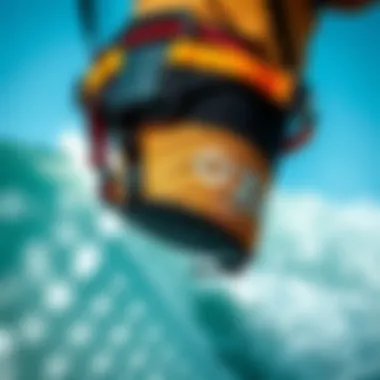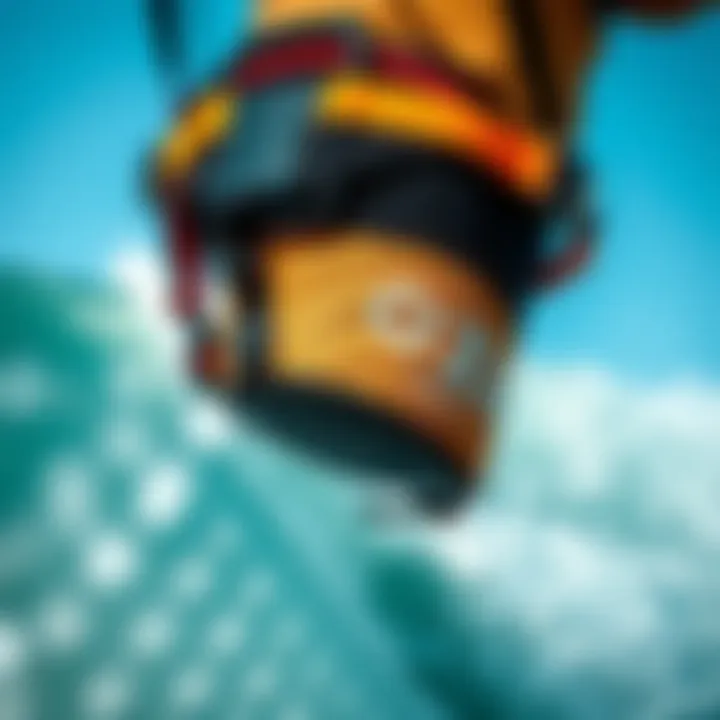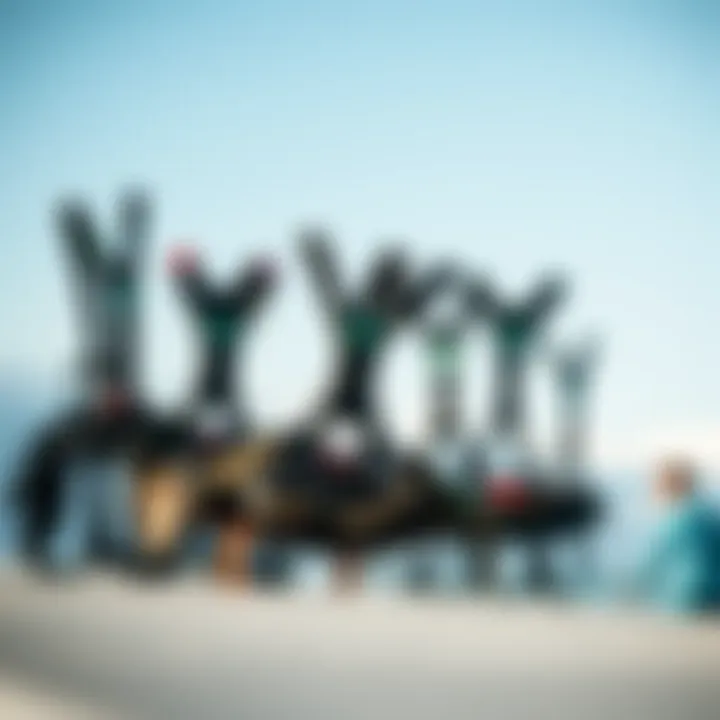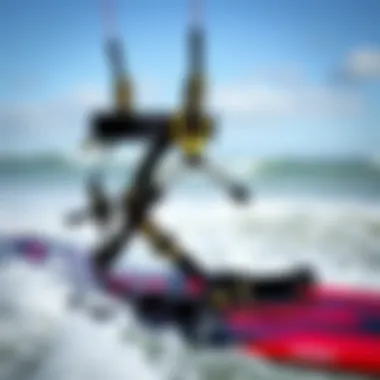Choosing the Right Kiteboard Harness for You


Intro
In the dynamic world of kiteboarding, the harness isn't merely an accessory; it serves as a critical link between the rider and the kite. For both newcomers and seasoned veterans, choosing the right kiteboard harness can be a daunting task, impacted by various factors including comfort, fit, and specific riding styles. This guide aims to demystify the selection process, providing detailed insights into the multitude of options available, and ensuring that enthusiasts can confidently choose a harness tailored to their needs.
Understanding the anatomy of harnesses is essential for every kiteboarder. Whether you're cruising along the water's surface or attempting gravity-defying tricks, the right harness greatly influences not just performance, but also safety and enjoyment. This article dives into key features, from ergonomic compatibility to the materials utilized in harness production, ensuring you don’t get lost in the gear jungle.
Moreover, we’ll share real-world experiences from kiteboarders, offering practical feedback on several reputable brands. Keeping abreast of the newest advances in harness design will also equip you with the necessary knowledge to navigate the latest innovations in the kiteboarding arena.
Techniques for Kiteboarding Enthusiasts
Kiteboarding not only requires the right gear but also sound techniques that complement your harness choice. Here, we break down essential skills that enable you to harness your potential on the water.
Beginner Techniques
For those just dipping their toes into kiteboarding, mastering fundamental skills is key. Start with the basics like stance and balance. A proper fit of the harness directly impacts your stance; if it’s too loose or too tight, it can throw off your center of gravity.
- Ensure the harness sits snugly on your body, allowing for mobility without restriction.
- Focus on the body posture; don’t lean too far forward or backward. A centered position will help maintain stability while handling the kite.
- Practice steering and controlling your speed, paying close attention to how the harness interacts with your movements.
These foundational techniques are crucial. As you get comfortable, you will naturally begin experimenting with speed and maneuverability.
Advanced Maneuvers
For the more experienced rider, the goal shifts towards mastering advanced maneuvers. Jumps, tricks, and aerial feats require not only refined technique but also a harness that offers both support and freedom.
- Pop Technique: Use your legs to push off the water while maintaining tension in the harness. Timing is everything for a successful jump.
- Tricks like the Backroll: Ensure that your harness allows for enough mobility in your torso. A high-back harness can restrict this movement.
- Handle Passes: This requires a proficient understanding of your equipment, including how shifts in weight impact your flight. A well-fitted harness enhances your ability to maneuver the kite effectively.
Acquiring these skills can lead to more exhilarating experiences and tricks. Many riders report that a good harness helped them progress faster in their skills.
"The right harness not only enhances performance but can also prevent injuries, allowing you to ride longer and harder."
Equipment Reviews
To further assist you in your selection process, we’ll delve into reviews of various harness types and models. Rigorous evaluations based on comfort, functionality, and durability will steer you towards informed decisions.
Harness Reviews
For comprehensive reviews, we’ll examine brands like North Kiteboarding, Mystic, and Duotone. Each of these brands presents a unique approach to harness design, focusing on distinctive qualities like:
- Material Quality: Look for durable yet flexible materials that enhance comfort.
- Ergonomic Design: The fit and shape play significant roles in performance.
- Safety Features: Harnesses with quick-release mechanisms increase safety and ease of use.
Useful Links for Further Research
Preparedness is key in kiteboarding. The right harness can significantly alter your experience on the water, ensuring that you can push your limits while remaining comfortable and safe.
Understanding Kiteboard Harnesses
When it comes to kiteboarding, the harness is as essential as the kite itself. Not many realize that, beyond just holding you in place, the right harness plays a pivotal role in enhancing your comfort and overall performance. Therefore, understanding kiteboard harnesses becomes a crucial part of deciding what will work best for you.
Definition and Purpose
A kiteboard harness is a piece of equipment designed to connect the rider to the kite. Think of it as the bridge that transfers the kite’s pull to the rider, ensuring that the energy generated while riding is distributed evenly across your body. This not only helps in sustaining control but also significantly reduces strain on the arms and upper body, which can wear you down quickly if the harness isn’t right. In simple terms, it makes the thrilling ride feel more manageable and enjoyable.
Historical Development
The evolution of kiteboard harnesses is as colorful as the sport itself. Traditionally, early kiteboarding harnesses were rudimentary and lacked support, often leading to discomfort and poor performance. During the late '90s and early 2000s, advancements in materials and design began to shape harness development.
With the introduction of neoprene and other durable synthetic materials, harnesses became lighter and more comfortable. Moreover, the design began to cater specifically to different styles of riding. The shift from simple seat designs to more complex hybrid models paved the way for a more tailored fit for individual kiteboarding styles. Today’s harnesses come equipped with features like quick-release mechanisms, padding for comfort, and advanced load distribution, which makes kiteboarding safer and more enjoyable than ever.
Importance in Kiteboarding
Why should you care about your harness? Well, here’s the thing: a poorly fitted harness can spoil your entire experience on the water. Just as a runner wouldn't wear ill-fitting shoes, kiteboarders shouldn't overlook harness selection.


The right harness benefits your performance in several ways:
- Comfort: A well-fitted harness minimizes fatigue, allowing you to ride longer without strain.
- Control: With optimized load distribution, the harness ensures better control over your movements as you navigate the waves.
- Confidence: Knowing you have the right support allows for risk-taking and experimentation, a vital part of learning and enjoying the sport.
In essence, the right harness could be your secret weapon. It not only impacts your performance but also enhances your overall experience on the water. With this foundational understanding in tow, we'll delve deeper into the types of kiteboard harnesses and how to select the optimal one for specific conditions and preferences.
Types of Kiteboard Harnesses
Understanding the different types of kiteboard harnesses is crucial for both newbies and seasoned riders alike. Each harness type serves distinct purposes, offering unique advantages and drawbacks based on riding style, comfort, and conditions. Choosing the right one can significantly improve your kiteboarding experience, enabling you to maximize performance and agility on the water while ensuring comfort and safety.
Waist Harness
Features and Benefits
The waist harness is one of the most popular choices among kiteboarders. Its design allows the rider to retain a high degree of mobility, facilitating dynamic movements across the board. With a sleek profile that sits snugly around the waist, these harnesses provide essential support without restricting motion. The primary characteristics include a lightweight construction, often made from durable materials such as nylon and neoprene, which withstand harsh elements while remaining comfortable.
One of the standout features is the ability to adjust the straps easily, ensuring a personalized fit. This is especially beneficial for those who want to fine-tune their harness based on how the wind pulls during a ride. Additionally, a well-fitted waist harness helps in distributing the load effectively across the lower back, making it easier to manage longer sessions without discomfort. However, some users might find that they prefer the added support of a seat harness when conditions get rough.
Suitable Conditions
Waist harnesses perform admirably in various conditions, particularly in moderate to strong winds. Their design makes them suitable for high-action tricks and fast-paced rides, as their low-profile nature allows for a broad range of motion. For kiteboarders seeking to master jumps or advanced maneuvers, the waist harness can be a game changer.
The flexibility it offers can be especially advantageous when navigating changing wind conditions or choppy waters. However, in lighter winds or for those just starting, it might not provide the same level of support that some beginners might require, which is where other options come into play.
Seat Harness
Design Elements
The seat harness is distinguished by its unique shape, which wraps around the upper thighs and back. This design element is particularly beneficial for riders who seek stability and support for longer sessions or in more challenging conditions. The distribution of pressure across the legs and lower back aids in reducing fatigue, making it a preferred choice for many.
Seat harnesses usually come equipped with a padded interior, providing extra comfort during long hours of use. The connection points for the kite lines are positioned lower, allowing for a more natural stance, which can enhance control. However, while the support is significant, there can be limitations in movement, particularly in jump-heavy styles, where freedom is favored.
User Insights
Many users express a strong affinity for seat harnesses, particularly novice kiteboarders or those transitioning from other watersports. The extra lower back support and anchored seating can instill confidence, helping users stay balanced and stable. Riders often report less strain on their bodies after lengthy sessions when using this type of harness.
However, some advanced users argue that the potential restrictions in upper body movement can be a turn-off for performing high-octane tricks. Users may need to weigh their needs based on their skill level and riding style, making this a thoughtful consideration when selecting a harness.
Hybrid Harness
Versatility
Hybrid harnesses combine features from both the waist and seat harness types, thus offering a balance between support and mobility. This versatility makes them an attractive option for those looking to dabble in different riding styles without committing to a single approach.
These harnesses often feature adjustable straps and a design that can suit varying preferences, allowing riders to find an optimal fit. The hybrid design enables comfort during both traditional riding and trick-oriented styles, serving as an all-rounder for many enthusiasts. However, if one's focus is heavily skewed towards a specific riding style, a more specialized harness might serve better.
Target Audience
The target audience for hybrid harnesses generally includes intermediate riders who are still exploring their preferences in kiteboarding. They cater to those who appreciate a balance of support without compromising mobility, thus appealing to a broad range of skill levels.
As such, these harnesses can attract individuals who enjoy switching their riding styles frequently or even experimenting with new techniques. However, experts might find the design lacking in specialization and, therefore, might lean towards more dedicated options as they advance in skill.
Key Features to Consider
Selecting the right kiteboard harness is not merely a choice of style or color; it’s about ensuring comfort and functionality while riding the waves. Understanding key features can mean the difference between an exhilarating experience and one riddled with discomfort. This section delves into vital factors to assess, laying the groundwork for making an informed decision.
Fit and Comfort
Size Options
When it comes to size options, every kiteboarder knows that a proper fit transforms the ride. If you find yourself wrestling with an ill-fitting harness, you're likely to experience discomfort that detracts from the joy of hitting the water. Different brands offer various size charts, but the key characteristic is getting a snug fit without being too tight. It's crucial to measure your waist correctly, as harnesses can vary significantly between manufacturers.
A unique aspect here is that some brands offer custom sizes or have a more extensive range. This is particularly beneficial for people who may fall into the gray area between standard sizes. For instance, someone who is a medium in one brand might find themselves a large in another. Opting for a company that provides tailored options could lead to a significantly better experience by ensuring that the harness hugs your body just right without pinching.
Adjustability


Adjustability is another cornerstone feature when discussing fit and comfort in harnesses. The key element of adjustability lies in the ability to customize the fit to accommodate different clothing layers or even your body's changing shape over time. Many harnesses come equipped with multiple adjustment points, allowing for quick and effective fitting.
What makes adjustability a sought-after characteristic is that it can help mitigate discomfort, especially during long sessions on the water. Suppose you’re out for a day of kiteboarding, and as the sun heats up, you start to feel some constriction. An adjustable harness lets you loosen it up without having to come ashore. However, it’s worth noting that adjustments can sometimes weaken over time, especially if they’re frequently loosened and tightened.
Material Quality
Durability
Durability is non-negotiable when it comes to selecting a harness. The ocean can be harsh; saltwater and sun exposure can wear down subpar materials at an alarming rate. High-quality polyester or even reinforced nylon is common in well-made harnesses, which add resilience against the elements.
Durability serves its purpose well throughout the harness's lifespan. An investment in a robust harness means fewer replacements, saving you money in the long run. However, it’s essential to ensure the quality level matches your type of use. For instance, if you are a more aggressive rider, opting for a harness made from sturdier materials could be advantageous, even if it’s on the heavier side.
Weight Considerations
Weight considerations often go hand-in-hand with material quality. A lighter harness enhances mobility and can be less fatiguing, allowing for a more enjoyable riding experience. These days, manufacturers are using advanced lightweight materials that don’t compromise on strength, offering the best of both worlds.
One standout feature about lighter harnesses is their reduced impact on overall performance, especially when you need to make quick adjustments mid-ride. That said, opting for a lightweight harness comes with its caveats. Some of the lighter options may sacrifice durability, which means they may not withstand rough conditions or heavy use as well. Always weigh your priorities when it comes to this feature, depending on your riding style.
Harness Spread
Load Distribution
Harness spread relates to how evenly the load is distributed across your body during rides. Proper load distribution is vital because it allows you to harness the kite's power effectively without straining any specific muscle group. Ideally, a well-designed harness should spread the force across your hips and lower back, enhancing comfort significantly.
The characteristic to focus on here is the contour of the harness; a well-shaped harness conforms to your body’s natural structure. Poor load distribution can lead to discomfort or even injury over time, particularly if you’re riding for extended periods. Look for harnesses designed with ergonomic distribution in mind, as they will likely offer a more enjoyable experience in the long run.
Impact on Performance
Finally, the impact of a harness on performance can’t be overstated. An effective harness will not only encourage better riding techniques but also allow you to enjoy longer sessions without fatigue. A harness that holds you in place while freeing your arms means you can focus on the kite instead of struggling against your gear.
The key attribute of a harness’s performance impact is how it integrates with your overall kiteboard setup. This multidimensional influence can elevate your riding experience considerably. However, a poorly chosen harness can lead to restrictive movements, stifling your ability to maneuver or ride effectively. The balance between securing you in place and permitting mobility is what makes the difference between a novice and a seasoned performance.
Selecting the Right Size
Choosing the proper size for your kiteboard harness is akin to finding the perfect pair of shoes; it can make or break your overall experience on the water. When you’re soaring above the waves or trying to execute tricks, the last thing you want is a harness that's too tight or too loose. An optimal fit contributes significantly to comfort, control, and performance. Since the harness acts as the primary connection between you and the kite, ensuring it sits snugly and comfortably is paramount. A well-fitted harness enables you to transfer energy effectively without unnecessary strain, reducing the risk of injuries and fatigue.
Measuring Techniques
To determine the right size harness, precise measuring is essential; it’s not just about picking the first one off the rack. Here’s a step-by-step guide to ensure you get it right:
- Waist Measurement: Wrap the tape measure around your natural waist, which is usually above the hips. Make sure to stand straight while measuring.
- Hip Measurement: This one might be slightly tricky, but it's vital. Measure around the widest part of your hips to ensure that the harness will sit comfortably without riding up.
When you have these measurements, compare them against sizing charts provided by specific brands. It’s not uncommon for different manufacturers to have variations in their sizing norms. For example, while one brand may define a medium as a 32-inch waist, another might size it at 34 inches.
"Harness fitting is a blend of skill and patience; just like tuning a kite, you need to get it just right for the best performance."
Common Sizing Issues
When it comes to sizing issues, we've all been there. Whether it’s a too-tight harness that pinches during rides or a loose one that fails to offer support, here are some common pitfalls:
- Overlooking Adjustability: Not all harnesses come with adjustment features. Ensure you opt for those that offer multiple buckles or straps to tailor the fit.
- Ignoring Body Type: Different body types require different consideration. A tall, slim person might find a standard harness too wide, while someone with a more robust build may struggle with sizes that fit around the waist but not the hips.
- Choosing Style Over Size: Some kiteboarders might prioritize aesthetics over functionality, opting for a harness that looks trendy but doesn’t fit well. Don’t let appearance fool you—comfort should always come first.
Arming yourself with accurate measurements and being aware of these common sizing issues will empower you to select a harness that meets your needs. Remember, when it fits properly, it can enhance your time riding waves and performing tricks, ultimately allowing you to enjoy kiteboarding at its fullest.
For additional insights on harness fitting and sizing, visit sources like Wikipedia on Kiteboarding or check the community discussions on Reddit Kiteboarding.
Utilizing these resources can provide greater clarity and foster a better understanding of what it means to select the right harness size.
Notable Brands and Models
When it comes to kiteboarding, choosing the right harness can make or break your experience on the water. This section delves into the notable brands and models available today, emphasizing the importance of selecting a trusted name in the industry. Knowledge about reputable brands ensures that you are investing in quality gear that meets your needs and performance expectations.
Overview of Leading Brands
In the kiteboarding world, several brands have earned their stripes. These companies are known not just for their high-quality products, but also for their continuous innovation in harness design. Some of the noteworthy brands include:


- Mystic: Often viewed as a pioneer, Mystic harnesses are recognized for their comfort and adjustable fittings. The brand focuses on a balance of style and performance, which appeals to a wide range of kiteboarders.
- Ion: Renowned for their ergonomic designs, Ion harnesses cater to users who prioritize comfort during long sessions. Their technology aims to enhance load distribution significantly, allowing riders to maintain optimum control.
- Dakine: With a strong reputation for durability and performance, Dakine harnesses are popular among seasoned riders. The range includes options that are well-suited for diverse conditions.
These brands have established their reliability through continuous engagement with the kiteboarding community, thereby refining their products based on direct consumer feedback.
Top Models Reviewed
Features Comparison
When assessing the best models, it's crucial to compare key features. This comparison sheds light on what makes one harness preferable over another. Key areas to focus on include:
- Comfort: How well does the harness fit? Is it adjustable? A good harness should conform to your body without pinching or constricting.
- Durability: The materials used affect longevity. High-quality straps and buckles can withstand the wear and tear that comes with kiteboarding.
- Weight: A lighter harness will allow you to perform better, especially during tricks or extended sessions.
For example, the Mystic Majestic harness is often praised for its exceptional back support, while the Dakine Wakesurf provides a lightweight experience without sacrificing stability. These varying characteristics inform riders' choices based on their personal preferences and riding conditions.
User Reviews
User feedback is invaluable when it comes to selecting harnesses. Real experiences can highlight strengths and weaknesses not immediately apparent from product descriptions. Here are some insights from kiteboarders:
- Fit: Many riders have expressed that the Ion harness fits snugly yet comfortably, which is especially favorable during high-intensity sessions.
- Feel: Some users might mention that certain models, like those from Mystic, provide an almost custom fit due to their adjustable nature. However, others may find that a particular model lacks sufficient padding.
"I switched to the Dakine harness last season, and the difference in comfort was night and day! It's lightweight enough that I almost forget it's there, but still super supportive during jumps."
These reviews often guide users in making informed decisions that align with their preferences and riding style. Many choose to explore forum discussions on platforms like reddit.com to gather insights from a community of enthusiastic kiteboarders.
In summary, awareness of notable brands and models enriches the decision-making process when selecting a kiteboard harness. With options tailored to various needs and preferences, riders can find a fit that enhances their overall performance and enjoyment on the water.
Maintenance and Care
Maintaining your kiteboard harness is not just about keeping it looking sharp; it's essential for ensuring longevity and peak performance during your sessions on the water. Like a well-oiled machine, if you take care of your gear, it will repay you with reliability and comfort when you need it most. Neglecting proper maintenance can lead to a host of issues, from reduced comfort to unexpected equipment failures that can sour a day out on the waves.
Benefits of Maintenance
Proper maintenance can greatly enhance the performance of your harness. It helps maintain its integrity and functionality, ensuring it effectively supports the weight and forces you experience while kiteboarding. Regular upkeep means you can focus on your performance rather than worrying about your equipment failing mid-session. It's all about being proactive; a little care today can save you a lot of headaches tomorrow.
Cleaning Recommendations
Keeping your harness clean is one of the foundational aspects of maintenance. After each session, rinse your harness with fresh water to remove salt, sand, and other debris. These elements can knick the fabric and hardware over time.
- Freshwater Rinse: After every use, especially in saltwater, give your harness a rinse to wash away the residues.
- Mild Cleaners: Use a mild soap or specialized cleaner designed for water sports gear. Avoid harsh chemicals, as they'll degrade the materials.
- Air Dry: Never put your harness in the dryer; instead, hang it to air dry in a shaded area. Sun exposure can lead to fading and weaken materials, which is the last thing you want for your supportive gear.
"A clean harness is a happy harness; it lasts longer and performs better."
Storage Best Practices
How you store your harness can significantly affect its lifespan and performance. While it might be tempting to toss it in a corner after use, a bit of organization will go a long way.
- Dry Storage: Ensure your harness is completely dry before storing it. Any moisture can lead to mildew and degradation of the materials.
- Avoid Direct Sunlight: Store your harness in a cool, dark place if possible. Direct sunlight can fade colors and weaken the fabric over time.
- Use a Gear Bag: Consider keeping your harness in a padded gear bag to protect it from physical damage, especially if you're traveling. A bag designed for water sports can also keep your harness organized with other essential gear.
By taking these simple maintenance steps, you not only prolong the life of your harness but also enhance your overall kiteboarding experience. Little efforts in keeping things clean and well-stored can pay significant dividends when it counts the most.
Future Innovations in Harness Technology
The arena of kiteboarding is ever-evolving, just like the gear that fuels this exciting sport. In the context of this article, the future innovations in harness technology hold significant relevance. As kiteboarding continues to attract a diverse crowd, advancements in harness design are poised to enhance safety, performance, and user experience, catering to a growing spectrum of enthusiasts.
Emerging Trends
In recent years, several trends have emerged that signal where harness technology is headed. These trends reflect a deep-seated desire among kiteboarders for better performance and enhanced comfort:
- Smart Materials: New materials that adapt to environmental conditions are making waves. Harnesses constructed with thermo-regulating fabrics can keep riders comfortable by adjusting to temperature changes during their rides.
- Integrated Safety Features: Manufacturers are increasingly focusing on safety, integrating features like quick-release systems and floating harness components. These elements help in emergencies, ensuring that a rider can detach quickly if they get into trouble.
- 3D Printing: This technology may revolutionize the customization of harnesses. With 3D-printed components, riders could enjoy tailor-made models that fit like a glove. This level of personalization wasn't feasible before, but it is becoming a reality.
- Ergonomic Designs: Advances in ergonomic technology will lead to harnesses that not only reduce fatigue but also improve support and pressure distribution on various body parts, especially during long rides.
These emerging trends signify a pivotal shift in the way harnesses are designed, directly impacting user satisfaction.
Potential Enhancements
As kiteboarding progresses, several potential enhancements can be anticipated:
- Wider Size Range: Future innovations may include a more extensive range of sizes and styles. Whereas traditional harnesses have been somewhat limited, diversity in designs may cater to varying body shapes, allowing for a better fit.
- Adaptive Structures: A night and day difference will come from harnesses that alter their shape based on rider movement and posture. This kind of innovation could minimize discomfort and better support the rider's natural biomechanics, especially during harsh conditions.
- Sustainable Materials: An increasing environmental awareness among water sports enthusiasts could result in harnesses made from eco-friendly materials. This shift could attract those who are committed to reducing their ecological footprint.
- Enhanced Connectivity: Imagine harnesses equipped with sensors that link with mobile apps to track performance. Such technology could offer analytics on ride patterns and suggest improvements, driving a new wave of performance-oriented kiteboarding.
“Innovation isn’t just about the new; it’s about making the old better.”
To put it all in a nutshell, the conversation surrounding future harness technology extends beyond mere equipment upgrades. It captures a philosophy that prioritizes rider experience and safety, Aligning with the core of kiteboarding. As we embrace these innovations, kiteboarders, instructors, and coaches can look forward to enhanced performance and unparalleled comfort on the water. For those keen on staying ahead in the sport, understanding these advancements will be key to selecting the ultimate harness for their needs.
For further insights on innovations, consider checking additional resources such as Wikipedia, Britannica or Reddit.















